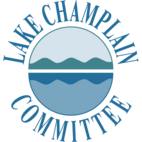The Lake Protection Pledge
August 2014

We can create a cleaner lake. Currently Lake Champlain has too many algae blooms, too many closed beaches and too many warnings about toxins in fish. Some of the pollutants that enter the lake come from our own homes and driveways. Taking the simple actions below can prevent nutrients, sediment and toxins from getting into the water from your household. Pledge to help the lake.
I/We Pledge To:
AROUND THE HOME
- Never dump toxic materials down stormdrains, garage drains, or on the ground. Waste dumped in stormdrains or on the ground is not treated before it enters waterways.
- Keep stormdrains and ditches clear of debris. Debris prevents proper drainage and causes flooding.
- Use paving stones, bricks, sand or gravel instead of paving with asphalt or cement. Paved surfaces shed water too rapidly; alternative materials allow stormwater to sink into the soil.
- Position gutters to drain onto grass, soil or into a rain barrel. This lets the water filter into the ground rather than flowing directly to streams.
- Clean up pet waste at home or when walking the dog. Dog and cat wastes contain high levels of bacteria harmful to people and the lake. Deposit pet poop in toilets or garbage cans.
- Replace wasteful fixtures such as shower heads, toilets and faucets that consume excess water. Conserving water equals conserving energy and home costs. Look for EPA WaterSense-labeled fixtures that are 20 percent more efficient and perform as well or better than traditional models.
- Use non-phosphate dishwasher detergents, it’s the law. Check labels - excess phosphorus leads to algae blooms.
- Have your septic tank inspected and pumped regularly. Without regular checks and pumping, septic systems can fail, causing severe water quality problems and costly repairs.
AROUND THE YARD
- Get a soil test and follow its recommendations for fertilizer use. Most lawns don’t need fertilizer, and whatever excess is applied ends up in the water, feeding algae growth.
- Use compost and mulch to improve soil health. These products release their nutrients slowly, providing long-term feed for your lawn and garden.
- Landscape with native groundcover and shrubs instead of lawn. Plants naturally adapted to local conditions require less maintenance and fertilizer.
- Choose drought-tolerant and pest-resistant plants. This minimizes the need for pesticides and excess watering.
- Avoid using pesticides and herbicides. They kill beneficial organisms as well as bothersome ones. When it rains, they wash into stormdrains and streams. Non-toxic insecticidal soaps, dormant oil sprays and "helpful insects" such as ladybugs can help keep pests at bay just as well.
- Leave grass clippings on the lawn. Grass clippings and other organic matter provide natural slow-release fertilizer and improve the lawn‘s ability to hold water.
- Maintain a vegetated buffer along the stream, river or lake if you live along a shoreline. Buffer strips shade the stream, filter runoff, stabilize streambanks, prevent erosion and provide habitat for animals.
- Water in the early morning to avoid losing water to evaporation during mid-day. Water slowly and deeply to avoid surface runoff, inspect hoses for leaks and direct overhead sprinklers toward vegetation and away from the street or driveway.
- Avoid over-watering. Excess water runs off the lawn into the stormdrain system.
- Reuse water collected in rain barrels. An inch of rainfall collected from an area the size of an average garage is over 150 gallons of water. Also reuse non-contaminated excess water from cooking or humidifiers to water plants and gardens.
- Re-seed thin areas in the lawn. Planting bare soil prevents erosion and sedimentation of water bodies.
AROUND THE GARAGE AND TOWN
- Wash the car on a lawn or at a commercial car wash. This minimizes the dirt and detergents entering streams through the stormdrain system. If washing at home, use an environmentally-friendly soap products and be sure never to leave the hose running when it’s not in use.
- Maintain the car with regular tune-ups and check for leaks. Leaking fluids end up on parking lots and are washed into stormdrains and waterways during the next rain.
- Dispose of oil and antifreeze properly. Keep it out of stormdrains.
- Reduce automobile trips. Take a bus, ride a bike, walk or carpool whenever possible. The average car emits about 900 pounds of pollution into the air each year and some of this ends up in the lake.
Lake Look is a monthly natural history column produced by the Lake Champlain Committee (LCC). Formed in 1963, LCC is the only bi-state organization solely dedicated to protecting Lake Champlain’s health and accessibility. LCC uses science-based advocacy, education, and collaborative action to protect and restore water quality, safeguard natural habitats, foster stewardship, and ensure recreational access.
Get involved by joining LCC using our website secure form (at www.lakechamplaincommittee.org), or mail your contribution (Lake Champlain Committee, 208 Flynn Avenue - BLDG 3 - STUDIO 3-F, Burlington, VT 05401), or contact us at (802) 658-1414, or lcc@lakechamplaincommittee.org for more information.
